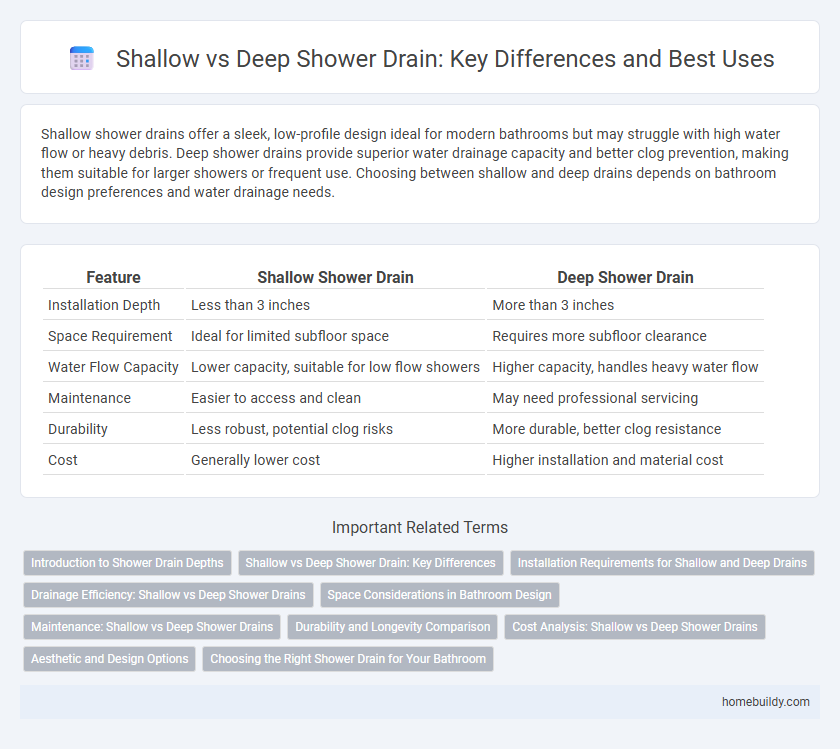Shallow shower drains offer a sleek, low-profile design ideal for modern bathrooms but may struggle with high water flow or heavy debris. Deep shower drains provide superior water drainage capacity and better clog prevention, making them suitable for larger showers or frequent use. Choosing between shallow and deep drains depends on bathroom design preferences and water drainage needs.
Table of Comparison
| Feature | Shallow Shower Drain | Deep Shower Drain |
|---|---|---|
| Installation Depth | Less than 3 inches | More than 3 inches |
| Space Requirement | Ideal for limited subfloor space | Requires more subfloor clearance |
| Water Flow Capacity | Lower capacity, suitable for low flow showers | Higher capacity, handles heavy water flow |
| Maintenance | Easier to access and clean | May need professional servicing |
| Durability | Less robust, potential clog risks | More durable, better clog resistance |
| Cost | Generally lower cost | Higher installation and material cost |
Introduction to Shower Drain Depths
Shower drain depths vary primarily between shallow and deep designs, each affecting water flow efficiency and installation flexibility. Shallow shower drains typically measure around 1 to 2 inches in depth, ideal for low-profile shower bases and quick drainage in compact spaces. Deep shower drains, often exceeding 3 inches, provide enhanced water capacity and are preferred for high-usage showers or those with thicker substrate layers to prevent clogs and ensure optimal drainage performance.
Shallow vs Deep Shower Drain: Key Differences
Shallow shower drains usually feature a low-profile design that simplifies installation and works well in bathrooms with limited floor depth, providing efficient water drainage without significant excavation. Deep shower drains offer enhanced water capacity and improved clog resistance, making them ideal for high-use showers or settings where rapid drainage is critical. The choice between shallow and deep shower drains depends on floor construction, water flow requirements, and maintenance preferences.
Installation Requirements for Shallow and Deep Drains
Shallow shower drains require minimal floor excavation, making them ideal for renovations with limited ceiling or floor space, while deep shower drains demand significant subfloor depth to accommodate their vertical drainage pipes. Installation of shallow drains often involves simpler plumbing adjustments and quicker integration with existing systems, whereas deep drains need careful planning to ensure proper slope and connection to main sewer lines. Choosing between shallow and deep shower drains depends on available floor thickness, water flow capacity, and compatibility with the building's plumbing infrastructure.
Drainage Efficiency: Shallow vs Deep Shower Drains
Shallow shower drains often provide quicker water flow for low-profile installations, but may struggle with high volumes of water and debris, leading to potential clogging. Deep shower drains offer enhanced drainage capacity by accommodating larger water volumes and debris accumulation, improving overall efficiency in high-usage showers. Selecting between shallow and deep drains depends on the shower's water flow rate and maintenance considerations for optimal drainage performance.
Space Considerations in Bathroom Design
Shallow shower drains require less vertical space, making them ideal for bathrooms with low floor-to-ceiling heights or limited subfloor depth, while deep shower drains need more space but offer enhanced drainage capacity. Choosing a shallow drain allows for a sleek, minimalist design that preserves ceiling height and prevents the need for extensive floor modifications. In contrast, deep drains are suited for larger bathrooms where space constraints are minimal and superior water flow management is a priority.
Maintenance: Shallow vs Deep Shower Drains
Shallow shower drains generally require more frequent cleaning due to their limited capacity to trap debris, leading to faster clogging. Deep shower drains offer enhanced sediment and hair collection capabilities, reducing maintenance intervals and minimizing the risk of blockages. Regular inspection and appropriate drain covers improve performance and extend the lifespan of both shallow and deep shower drains.
Durability and Longevity Comparison
Shallow shower drains typically feature simpler construction with fewer components, which can enhance durability by reducing potential failure points. Deep shower drains often use more robust materials and designs that provide increased resistance to heavy foot traffic and water pressure, contributing to extended longevity. However, proper installation and regular maintenance are critical factors influencing the lifespan of both shallow and deep shower drains.
Cost Analysis: Shallow vs Deep Shower Drains
Shallow shower drains generally cost less due to simpler installation and reduced excavation requirements, making them ideal for renovations with limited floor height. Deep shower drains, while more expensive upfront, offer superior water flow and clog resistance, potentially lowering maintenance costs over time. Evaluating total cost of ownership, including installation, durability, and upkeep, is critical in choosing between shallow and deep shower drains.
Aesthetic and Design Options
Shallow shower drains offer sleek, unobtrusive profiles that seamlessly blend with modern minimalist bathroom designs, enhancing aesthetic appeal without compromising floor space. Deep shower drains accommodate larger grate patterns and custom designs, allowing for bold, decorative statements and enhanced water drainage efficiency. Selecting between shallow and deep drains depends on the desired balance between subtle elegance and distinctive design emphasis in shower aesthetics.
Choosing the Right Shower Drain for Your Bathroom
Shallow shower drains offer a sleek design ideal for low-profile shower floors and easier maintenance, while deep shower drains excel in handling higher water flow and debris in larger bathrooms or wet rooms. Selecting the right shower drain depends on factors like shower base depth, drainage capacity, and overall bathroom layout to ensure efficient water management and prevent clogging. Prioritize compatibility with your shower pan and consider the installation environment to optimize drainage performance and longevity.
Shallow shower drain vs deep shower drain Infographic

 homebuildy.com
homebuildy.com